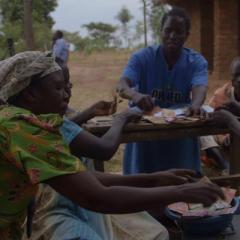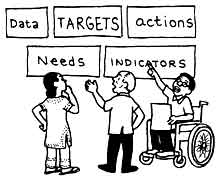Your progress
0%
complete
A situation analysis involves the following activities.
Use your mouse or keyboard to expand each of the headings below. To add an activity to your action plan, select the Add button beside it.
Holding a stakeholder forum is a good way to review and discuss the findings from Stage 1 to determine priorities, design programme plans and prepare budgets.
Representatives from as many stakeholder groups as possible should be invited to participate in the forum.
It is especially important that people with disabilities and their family members are well represented at the planning stage. To this end, consideration should be given to making the forum accessible, for example by preparing information in accessible formats. It may also be necessary to hold separate forums for people with disabilities and their family members to ensure they are able to express their views easily and freely.
Let’s look now at the story of a CBR programme in Uganda that did not initially involve people with disabilities in its planning activities, and the dramatic improvement that took place once it did. Select the Learn more link below to watch this story.
See how including people with disabilities in its planning process allowed CBR in Uganda to make a big difference.

When you have finished watching this video, consider whether your programme is doing enough in terms of including people with disabilities in your planning and decision-making.
How might you be able to improve? Enter your thoughts in the box below; and select Save when you are finished.
It is likely that, although many of the needs identified in Stage 1 could be addressed by CBR, resources are not unlimited and priorities will have to be set. It is important that people with disabilities and other key stakeholders actively participate in the priority-setting process to ensure that the programme will be relevant and appropriate to their needs.
A particularly useful exercise is to rank each of the possible actions through a variety of different “lenses”, such as:
Prioritization requires skill and an understanding of the realities of the situation. Sometimes external facilitators can help prevent deviations from the programme goal.
The logical framework (“log frame”) is a planning tool useful for preparing a plan for the CBR programme. A log frame ensures that all aspects required for a successful programme are taken into consideration. It tries to answer the following questions.
Select the following links to see examples of:
An understanding of the following steps is important for preparing a CBR programme plan using a log frame. Note that some of the log frame terms used below may be different from those used by other organizations, funding bodies, etc.
An understanding of the following steps is important to prepare a CBR programme plan using a log frame.
Use your mouse or keyboard to expand each of the headings below.
Before thinking about what outcomes are desirable and what activities need to be done to accomplish them, it is important to put the whole CBR programme plan into a broader disability-inclusive development context: What is the overall point, the long-term inclusive development goal that this programme (and very likely many other programmes as well) is aiming for? Ultimately, CBR is a strategy for inclusive development for people with disabilities, so the goal must be a feature of disability-inclusive development.
In addition, the goal will typically extend beyond the particular community or communities in which most of the activities of the CBR programme will be conducted. The goal will normally involve a long-term sustainable change across the nation and region that secures the full inclusion of persons with disabilities in mainstream services and opportunities.
Because of the fundamental nature of goals, it will usually involve one or more of the human rights set out in the CRPD: the right to work, to education and to political participation. This means that the goal of a CBR programme must also be compatible with the national responsibility to implement the human rights in the CRPD.
The purpose of the programme describes the changes the programme will make towards achieving the goal. Usually, there is only one purpose, as this makes programme management easier. However, some CBR programmes may have more than one purpose because they may want to focus on several different components/elements of the CBR Matrix (e.g. health and education). In this situation, separate log frames will be required, but each log frame should share the same overall goal.
The purposes of the programme are the actual, concrete changes in the community that the programme will make towards achieving the basic goal. The purposes are linked to the components and elements of the CBR matrix, so a programme may be directed at one or several purposes. When the programme has more than one purpose, it is advisable to use separate log frames for each (see Stage 1: Problem analysis).
The outcomes are what the CBR programme wants to achieve, the intended results or products of the activities that are planned. There are usually no more than 3–6 outcomes for each log frame (see Stage 1: Objectives analysis).
Activities are the actual work or interventions that need to be carried out to achieve the outcomes that serve the short-term purposes, and perhaps in combination with other outcomes. The log frame should describe only key activities, and only in simple language. More detailed activities are considered later on in the management cycle, when the work plans are developed (see Stage 3: Develop detailed work plans).
Resources are human, financial, material and in-kind, including the resource of time. These are the resources that the programme will require in order to carry out the selected activities and achieve the desired outcomes.
Indicators are numbers, proportions, percentages or rates that measure (“indicate”) the extent to which planned activities have been conducted and targets (outcomes) have been met with respect to short-term purposes and long-term goals. Usually there is a natural order of indicators that measure each stage from inputs and activities to purposes and goals.
Indicators are the principal tool used for monitoring implementation (monitoring) and evaluation (evaluation).

It is important to include people with disabilities in the process of creating indicators for a CBR programme. They can help with input and process indicators as well as outcome indicators that measure:
After the indicators have been defined, it is essential to decide what information or numerical data are needed to input into the indicator. These sources of verification will always need to provide information that compares the situation for persons with disabilities with that of those without. The following are examples of sources of such information:
When deciding on sources of verification, it is also important to think about when, where, how and by whom data will be collected. It is important to include people with disabilities and other community members in these decisions.
Mobile technologies such as phone apps are a useful and inexpensive way to collect information from programme clients and community members and to share this information quickly and easily.
To complete the assumptions column of the log frame, risks and other obstacles that might occur during the programme should be considered. There are risks associated with every CBR programme, yet identifying them early on will help in preparing for them. Once identified, risks and other problems can then be managed by changing the programme plan to reduce or eliminate the chance that they will occur. These risks and problems, stated positively, are the assumptions that can be included in the log frame.
All programmes should have monitoring and evaluation systems. It is essential that these systems be considered during the planning stage so information can be collected as soon as implementation of the programme begins. The indicators and the sources of verification that were identified are the basic foundation for monitoring and evaluation systems (see Stage 3: Implementation and monitoring and Stage 4: Evaluation).
It is important to identify the required resources and plan how these can be obtained. Resources may come from civil society, mainstream organizations or various levels of government; other resources will need to come directly from the programme.
It is important to consider the long-term sustainability of the programme when specifying what resources will be required. It is also important to make sure that all budgeted expenses are inclusive of the actual costs needed to work with people with disabilities.
Remember to refer back to the resource analysis carried out in Stage 1 to identify the resources that already exist (see Stage 1: Resource analysis).
A budget describes the amount of money that the programme plans to raise and spend to implement its activities over a specified period of time. A budget is important for transparent and accountable financial management, for fundraising and programming monitoring and evaluation. Knowing how much a programme will cost is information donors will need to know, showing how their money will be spent; it is also essential for comparing budgeted costs with actual costs during programme evaluation. In budgeting it is essential to keep in mind the long-term sustainability of the programme, and to build on existing and locally available resources.
Programme budgets should be prepared very carefully. If you do not have a large enough budget, you may be unable to carry out some programme activities or to sustain the programme in the long term; if you set the budget too high, however, partners and donors may be unwilling to fund and support the programme.